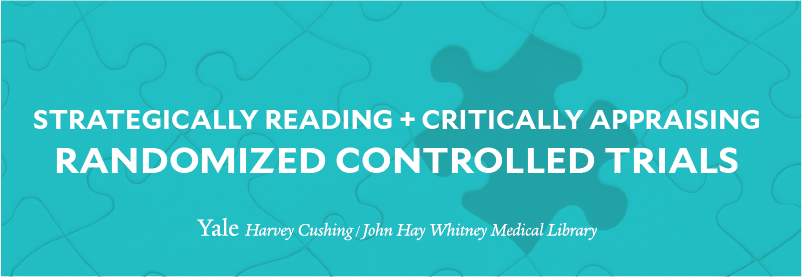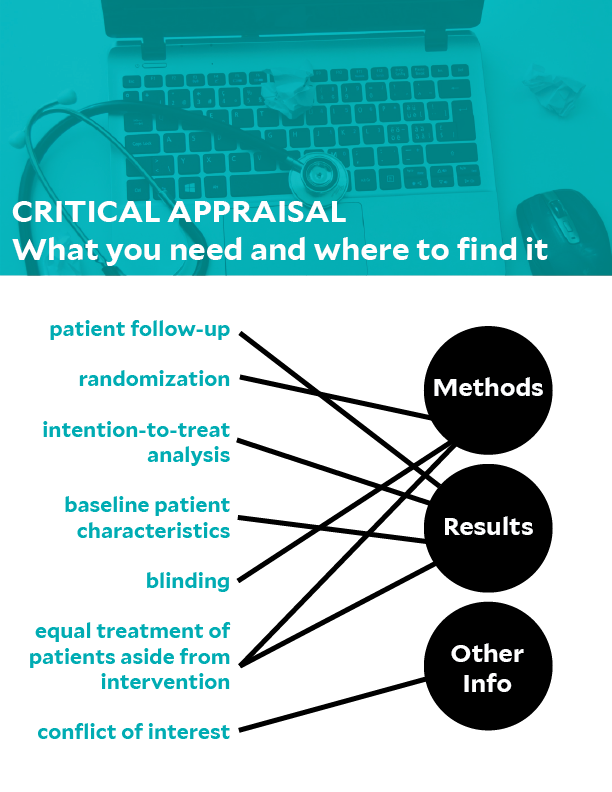Signature Assignment

Digital media checklist reflections: This header image modifies an image from Pexels in Illustrator to title the module. It has alt text, is within our branding, and is easy to read.
Overview
When published guidelines and point-of-care information resources such as UpToDate or DynaMed Plus do not have the answer to clinical questions, healthcare professionals turn to the journal literature. Randomized controlled trials (RCT) are considered the ideal type of study to determine, without bias, the benefit or harm of an intervention and are often sought as evidence-based, authoritative sources of information to answer questions about complicated clinical scenarios. However, healthcare professionals do not have time to read lengthy and complex documents.
The goal of this module is to prepare third-year medical students in their clinical clerkships for the situation laid out above. By the end of the unit, students will be able to look at an RCT, quickly locate key pieces of information about the study design, and use a tool called a critical appraisal worksheet to evaluate the evidence. This unit will live in a series of online self-directed learning activities the students can access during their clerkship year.
Before you start
Before jumping into reading, it’s a good idea to know exactly what you’re looking for. Constructing a well-built clinical question is crucial to saving time and having a more focused literature searching and reading experience. Check out the video below for tips on how to frame a clinical question using the PICO tool.
Digital media checklist reflections: Since I made this video, it aligns with the checklist closely. It is correct information, conveyed similarly to how we’d present it in person, and meets branding guidelines. It is accessible, importantly, and could easily add assessment by having interactive layers on top of the video that encourage the viewer to pause and attempt the activity themselves before the video shows the answer. It fits in well to this module because it gives the viewers a nice background and context to operate within before blindly diving into the literature.
Now that you have a question
What exactly is an RCT? Why are they so important? Listen to this brief podcast for a little historical context:
Digital media checklist reflections: Though the content is concise and related to our task at hand, I’m unsure if Soundcloud is accessilbe as a platform. I’d probably need to add the text of the script somewhere. The Soundcloud interface is something my target audience is familiar with so I do not anticipate usability issues there.
Anatomy of an RCT
Peruse the annotated digital document below to learn more about the common components of an RCT and see them in context.
Digital media checklist reflections: This content checks all of the boxes in content and licensing (it is an open access article despite the odd footnote on each page). If I were to do it again, I’d try to make it more aesthetically pleasing or try building an interactive component to get across this idea. Assessment will come in at the end of the whole string of content, but will tie back to this piece.
Critical appraisal
Before investing the time in reading the entire RCT report, the first stage of critical appraisal is a high level screening evaluation of the paper. Ask yourself:
- Does the study content match the clinical question? Consider your PICO.
- Is the study design appropriate for your clinical question type? Consult the table below:

Digital media checklist reflections: I realized I needed to add alt text, so this exercise was useful. The content is concise, visually appealing, and correct. I am confident in its inclusion and contribution to the learning objectives.
Next, you’ll collect information from the report to assess the validity of the study design and execution. The graphic below will tell you what you’re looking for and where to find it.

Digital media checklist reflections: this content is very crucial to the achievement of the learning objectives. I think it conveys information in a concise and clear way. It reads intuitively and, since I made it, is fine to license. The header image is from Pexels and was modified in Illustrator. Its license does not require attribution.
After you gather this information, it’s time to calculate the number needed to treat. For easy to understand instructions on calculating experimental event rate, experimental control rate, absolute risk reduction, and, finally, number needed to treat, check out this great video from Sketchy EBM:
Digital media checklist reflections: This video is great! It presents the content in an understandable and clear way and is honestly better than what I’ve seen in person. It doesn’t have an assessment piece, but one could be very easily attached. The audio is clear and the licensing allows embedding with credit.
Now that you’re familiar with the formulas required to calculate NNT, try looking at a study and using this calculator to make the calculations.
Digital media checklist reflections: Though not a typical OER, this calculator has a lot of great information on how the calculations work and some illustrative examples to reiterate the points make in the video above. I think the students’ chance to try out some numbers by interacting this page is a pedagogically worthwhile exercise. Running through the checklist, this page acts as a mini-self assessment, which is nice, is accessible according to WAVE, and is intuitive and accurate. Definitely checks all the boxes.
Checking your knowledge
This interactive module has some review information as well as a quiz to test your knowledge.
Digital media checklist reflections: This interface is clean and intuitive, based on WAVE Web Accessibility Tool it passes, and the content is correct. If I were to really implement this tool into my workflow, I would want to rebrand it to be more in line with our color scheme and patron expectations.
License information
Everything on this page made by me (everything except the Sketchy EBM video and the NNT calculator) have a CC-BY-NC license. Thanks!